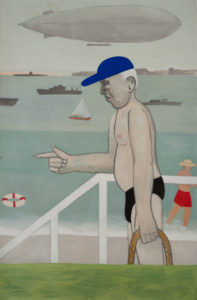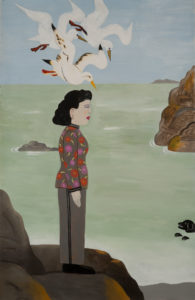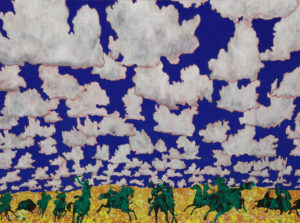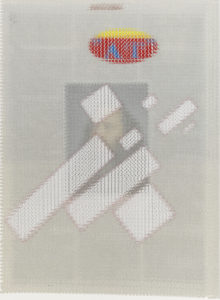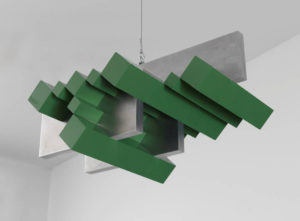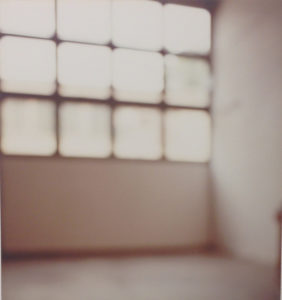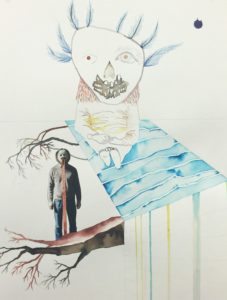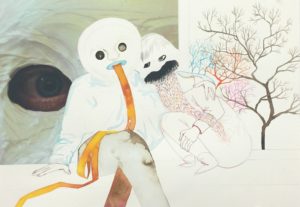February 18, 2016—April 2, 2016 | Reception Saturday, February 20th, 3-5pm
James Harris Gallery is pleased to present “Tunnel of Silence”, a group exhibition featuring painting, sculpture, photography, and works on paper by artists Uta Barth, Claire Cowie, Fay Jones, Aaron Morse, Richard Rezac, John Sparagana, and Akio Takamori. The title is a reference to a quote by poet Adrienne Rich who stated in her 1997 lecture Arts of the Possible, “The impulse to create begins — often terribly and fearfully — in a tunnel of silence.” With a more hopeful tone, Rich went on to say, “Silence … can be fertilizing, it can bathe the imagination, it can, as in great open spaces… be the nimbus of a way of life, a condition of vision.” The works in this show demonstrate how art is both the product of and the impetus to these productive moments, making us slow down enough to become conscious of our surroundings, and often forcing us to confront a difficult reality. Silence is what happens in moments of interstice when we hover between thought and action. This contemplative pause creates space and allows for new ideas, perspectives, and relationships to take form. This can be disorienting and uneasy, where preconceptions are challenged and change becomes necessary. But we are also reminded that nothing is static, these moments are fleeting, and we evolve.
Seattle artist Fay Jones has been developing her eclectic vocabulary and surrealist style in her painting for over 40 years. Jones’ work is infused with personal myth and fantasy, and offer signifiers to evoke imaginative associations. These narrative works pivot around tension, creating unsettling juxtapositions and setting the stage for imminent conflict to arise. In her new works, “Sono, the Sentinel” and “Sea Dog, the Sentry”, Jones presents a central figure with the backdrop of a seascape. The peaceful tranquility of these moments is offset by an air of anxiety, where this silent pause requires an impending action that would shift the narrative in a new direction. Aaron Morse’s landscapes similarly resist the passive enjoyment of awe-inspiring landscape painting. In his large-scale work “Cloud World (Horsemen)”, Morse creates a dreamscape paying homage to Maynard Dixon, the early 20th century Western Landscape painter. His painting is colorfully composed with a low horizon and an expanse of surreal tracts of cumulous sky; each cloud illuminated with an unnatural glow and orderly arranged. The artist activates this tranquil scene with horsemen on a buffalo hunt; the men, horses and beast painted in army green and paused in action as if they were toy soldiers. Morse’s “Cloud World” is a nod toward episodes from history or myth but the painting is rooted in the contemporary. Morse is driven by the vexed urge — irresistible, yet futile—to make sense of the big picture: the past, the present, how they connect, where we’re headed.
Richard Rezac’s minimal abstract sculptures embody the vernacular of the ordinary as well as the sublime. His application of reductive forms mimic systems of natural order and explore repetitive rhythm and the interplay between presence and void. The intimate scale of these meticulously crafted material pieces create a contemplative space for the viewer. With broad influences such as the aesthetics of Japanese Zen gardens, American Minimalism, Baroque architecture, and geometric systems, Rezac is interested in communicative forms in physical space. “Untitled (09-07)” hangs overhead, activating a dynamic spatial relationship that expands the viewer’s awareness of the surroundings.
Since the early 1990’s, Los Angeles based artist Uta Barth has created abstracted photographs, exploring how the incidental and atmospheric can become subject matter in and of themselves. Regarded for her “empty” images that border on painterly abstraction, the artist carefully renders blurred backgrounds, cropped frames and the natural qualities of light to capture incidental and fleeting moments. Barth renders landscapes and everyday spaces all but illegible by employing an extremely shallow depth of field. In doing so, she ruptures the age-old emphasis in photography on the referent and instead turns her audience toward its own experiences.
Other works comment on the failure of verbal language, offering alternative and imaginative modes of communication to express ideas that are difficult or perhaps impossible to speak about, turning the personal into a shared experience. Akio Takamori’s freestanding sculptures investigate the interface between contemporary society and the flux of diverse global cultures that impinge on it. He continues to explore the realm of human experience and rational social behavior through figures of youth and old age. Monumental in scale and personality, “Yellow Karako” depicts a young sitting monk as if he is meditating. The artist posits important questions about individual history and cultural perceptions. Claire Cowie sees art as a communicative language. Her work usually centers on the world around her as she develops ideas and personal iconography based on family, friends and experiences. Her works on paper have always been rooted in the landscape of the mind as well as the physical landscape surrounding her.
Chicago artist John Sparagana refers to his collage works consisting of found mass-media materials as “ghosts” or “ruins”. His process of breaking down iconic and associative media images and re-presenting them as muted abstractions gives them an unexpected physical presence, and offers a lament for an ecstatic mode of communication, an elegy on impermanence. They encourage us to consider our daily media encounters with deeper attention to the realities behind the entertaining flash of “the news.” There is something productive that happens with this intervention so that these ambiguous images may provoke many different meanings, emotions, thoughts, and ideas. As Sparangana says of his practice, “It’s not about how they’re made, but where that leads.”
Claire Cowie
Claire Cowie uses a variety of media to reference the natural world around her home in Seattle, as well as around the world. Cowie utilizes symbols of the natural world such as birds, insects, and a variety of plant-life, as well as heavily using the negative space in a work. By using watercolor and ink in the areas around her subject Cowie references the fragmentation between the natural world and us, as well as of memory. The colors and shapes in her work create dream-like landscapes that pull in characteristics of urban architecture.
Claire Cowie lives and works in Seattle, Washington, where she is a lecturer at the University of Washington. Cowie attended both the North Carolina School of the Arts (Winston-Salem, NC) and Washington University in St. Louis (St. Louis, MO). She received her MFA from the University of Washington (Seattle, WA). Cowie’s work has been exhibited both nationally and internationally, including shows at the Henry Art Gallery (Seattle, WA), Takeda Biennial (Oaxaca, Mexico), Tacoma Art Museum (Tacoma, WA), Frye Art Museum (Seattle, WA), Shenzhen Art Institute (Shenzhen, China) and the Art Gym at Marylhurst University (Lake Oswego, OR). Her work is included in the collections of the Henry Art Gallery (Seattle, WA), Microsoft Corporation (Redmond, WA), Safeco (Seattle, WA), and Tacoma Art Museum (Tacoma, WA), among others.
Akio Takamori
Takamori was a seminal figure in ceramic art, whose work over the past thirty years has left an enduring impact on the Pacific Northwest arts and the medium itself. His work is often autobiographical, drawing on his life in Japan, his family, and mythological themes. He is known for his coil-built figurative sculptures in which the narrative painting defines the form. Takamori explored themes of cultural identity by engaging the history of Eastern and Western aesthetics. Bold form and color defines his body of work, which is highly expressive of human emotion and sensuality.
Akio Takamori was born and raised in Japan. He has been exhibiting in the United States, Europe and Asia since the mid 1980s. Takamori received his BFA from the Kansas City Art Institute in 1976 and his MFA from the New York State College of Ceramics, Alfred University in 1978.
Takamori’s work is included in numerous collections including the Nelson-Atkins Museum of Art in Kansas City, Los Angels County Museum of Art, Victoria & Albert Museum in London, Ariana Museum in Geneva, the Seattle Art Museum, and the Museum of Arts and Design in New York City. He is the recipient of numerous awards, including three National Endowment for the Arts Visual Artists Fellowship Grants (1986, 1988, 1992), the Joan Mitchell Foundation Painters and Sculptors Grant (2006), and the USA Ford Fellowship (2011). Takamori was a professor of art at the University of Washington. He lived and worked in Seattle.
Fay Jones
Fay Jones’ work conveys the intimacy of mind, emotion, and spirituality. As a whole, Jones’ paintings echo a tremendous sense of humanity. The pieces meld figures, animals and symbols to conjure up existential meaning of human experience. Her characters become signifiers, representing the watery depth of the unconscious.
Fay Jones received a BFA from the Rhode Island School of Design in 1957. Awards she has received include the Joan Mitchell Painters and Sculptors grant in 2013, the Seattle Art Museum’s 2006 Poncho Artist of the Year award, grants from the NEA in 1983 and 1990, the Washington State Arts Commission in 1984, and La Napoli Art Foundation in 1989. Her work has been extensively collected in the Northwest, and is included in the collections of the Portland Art Museum and the Hallie Ford Museum of Art in Oregon, and the Seattle Art Museum and the Tacoma Art Museum in Washington, as well as the Cities of Seattle and Portland. Major exhibitions include a 2007 retrospective at the Hallie Ford Museum of Art at Willamette University, a 1997 traveling retrospective with the Boise Art Museum, and exhibitions at the Portland Art Museum, the Seattle Art Museum, the Museum of Northwest Art in La Conner, WA, the Anchorage Museum of History and Art, and the Palm Springs Desert Museum in California.
Richard Rezac
Richard Rezac (b. 1952, Nebraska) creates refined, and elegant objects comprised of pure reductive forms; his inspiration drawn in part from emotive encounters with architectural and design details situates his work closely to the Post-minimalist artists of the 1980s. Human in scale and mounted on the wall, suspended from the ceiling, or placed on the floor, Rezac’s sculptures open viewers to close-looking and reflection upon the forms. Surfaces of painted and natural wood, aluminum and bronze contain subtleties that reveal the pristine sculptures as actually handmade. Richard Rezac has received prestigious awards including the John Simon Guggenheim Memorial Foundation Fellowship, the Joan Mitchell Foundation Award, Louis Comfort Tiffany Foundation Award, and the Rome Prize Fellowship from the American Academy in Rome. He has exhibited at the Art Institute of Chicago, Museum of Contemporary Art- Chicago, Yale University Art Gallery, Aspen Art Museum, Portland Art Museum and others. Public collections include the Art Institute of Chicago, Dallas Museum of Art, Portland Art Museum, Detroit Institute of Art, and the Smart Museum at the University of Chicago, among others. Rezac lives and works in Chicago, IL where he is Adjunct Professor of Sculpture, Drawing, and Graduate Advising at The School of the Art Institute of Chicago (SAIC).
(copied from Rhona Hoffman)
Acrylic and collage on watercolor paper, ragboard mounted on doorskin
68" x 44 1/2"
Private Collection, Santa Monica, CA
Acrylic and collage on watercolor paper, ragboard mounted on doorskin
68" x 44 1/2"
Private Collection
Acrylic and oil on canvas
52" x 70"
Inquire about this work
Sixteen fatigued magazine pages with oil stick, sliced on mixed paper
44" x 33"
Inquire about this work
Painted wood and aluminum
12" x 20 1/2" x 17"
Inquire about this work
Chromogenic print mounted on panel
16 1/8" x 15 1/8"
6/8
Inquire about this work
Collage, ink, graphite
15" x 11"
Inquire about this work
Collage, ink, graphite
11" x 15"
Inquire about this work

